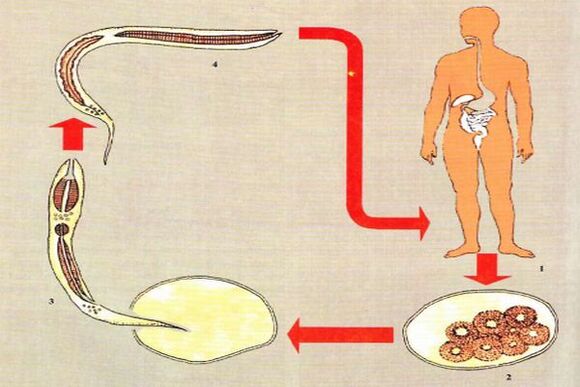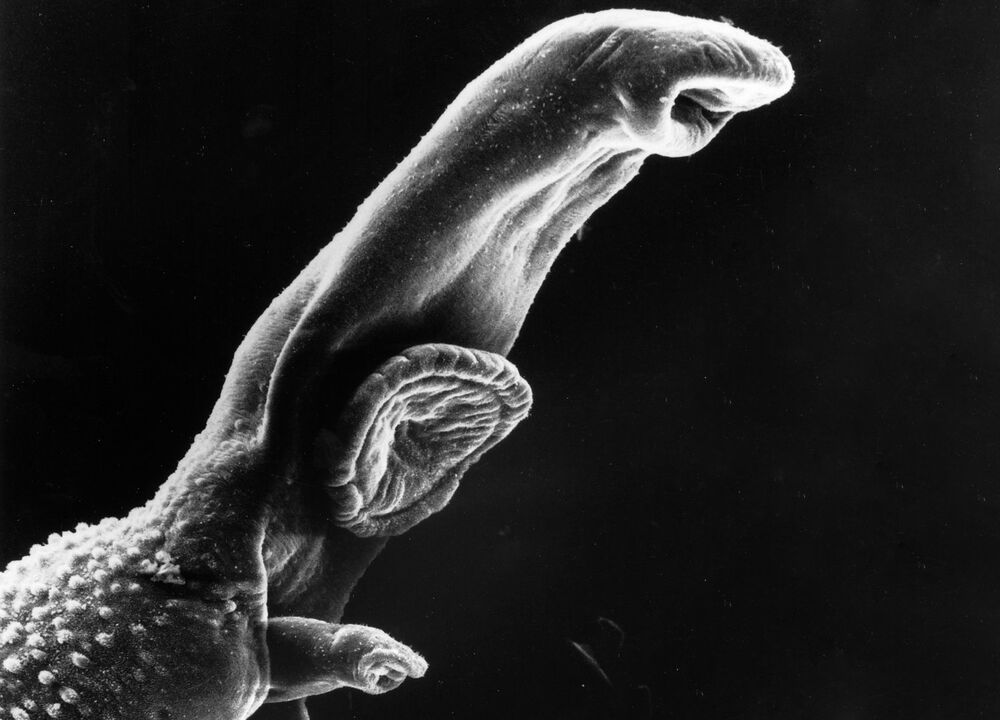Life cycle- this is the totality of all stages of development "from egg to egg", and in the absence of eggs, from any stage to the nearest similar stage. The main biological aspects of the life of any organism are adaptations that ensure the preservation of the individual and the species.
In parasites (unlike free-living animals), nutrition is continuously provided, so the body's reproductive activity increases. The increasing reproduction of the parasite due to the spatial and temporal limitations of its habitat leads to rapid overpopulation of the place and the need for resettlement of the species to preserve it.
The totality of all stages of a parasite's generation and its transmission routes from one host to another is called its life cycle.
Types of cycles
Having discovered that parasites are organisms that use other organisms to develop, it is important to understand what the options are for the development of life. According to classification, there are simple and complex cycles. The first happened without a change of ownership. Examples include the growth of roundworms, amoebas, roundworms, etc. v. A complex group includes multiple servers at once. These can be vertebrates, fish, shellfish, etc. v. An example is helminths.
The development cycle of whipworms does not require an intermediate host.
After entering the final host, the parasite grows and multiplies. Depending on the type of pathogen, the larvae can stay inside or leave the body. In most cases, excretion occurs through the intestines. This helps determine the type of pathogen through simple tests.
Characteristics of cyclic phases
Each stage of development has its own characteristics. Even treatment is determined solely based on this factor. This is explained by the fact that, for example, not all drugs have an effect on larvae, while it is much easier to get rid of adult parasites.
Carriers of intermediate and final parasites depend on the type of helminthiasis.
In this regard, let's see how the development cycle goes:
- Dispersal - this cycle exists when an intermediate host, which is the source rather than the terminal stage, is considered the only option at the moment, i. e. there is no potential final host. In such a situation, the intermediate host is used for continued growth and nutrition.
- Active growth - when the most suitable conditions are reached, the parasite stops, repairs itself if the right equipment is present and begins to grow to a sexually mature state.
- Migration to another habitat - after an adult individual reproduces with eggs, in most cases they migrate for further development. They can be distributed in many different ways. Normally, parasites move through the digestive system along with food masses. There are also types that, due to their large size, easily enter the bloodstream and spread throughout the body.
- Asexual reproduction - some types of parasites are distinguished by the fact that they do not need a second partner for reproduction. The most prominent example is the tapeworm, in which each strobila has a uterus that produces mature eggs.

Important concept
The first thing that needs to be emphasized when getting acquainted with parasites is the concept of "host". This is an organism in which the development and reproduction of parasites occurs. The "intermediary server" stands out separately. In this case, the pathogen remains inside the body until it has a chance to move to the most favorable environment provided by the final host.
Cycles can occur when there is a change of 1-4 hosts. In this case, the first is intermediate and the rest are complementary. Through direct contact or through an intermediate host, the parasite enters the final host. This is where sexual development and reproduction takes place.
The development of the parasite begins when it invades the final host.
There are also concepts such as reservoir parasites and host feeders. In the first case, we are talking about a situation where the parasite, having reached suitable conditions, can remain unchanged for a long time, waiting for a more favorable solution.
supplier owneris an organism used exclusively as food. The simplest option is pliers. By understanding how these parasites feed, it can be understood that they need human blood to survive, but they do not survive in or on the human body for long periods of time.
The concept of "parasite reservoir" or "reservoir host" is also distinguished. This is a host in which pathogens can exist for a long time, accumulate, multiply and spread throughout the surrounding area.
Parasite biology
The carriage of parasites is considered separately - in cases where pathogenic parasites live in the human body, but the development of the disease does not occur. However, such a person poses a danger to others.
The parasite and its host influence each other.
Harmful effects of parasites on the host:
- Mechanical;
- Toxic;
- Withdrawal of food;
- Violation of tissue integrity.
Accordingly, the host body "emits" a response to the impact of the parasite.
Parasitic infections can be divided according to the susceptibility of the pathogen to the host:
- Humanity - humans act as hosts;
- Zoonotic - many animals act as hosts;
- Arthritis is a common infectious and invasive disease in humans and animals.
Medical parasitology includes 3 main parts:
- Single-celled parasites - protozoa.
- Parasitic worms, helminths - helminths.
- Arthropods - spiders.

Life cycle stages
In most cases, protozoa have specially adapted stages to make the transition from one host to another. These stages are called viral.
In intestinal parasitesbreeding stageoften adapt to experiences in the external environment. Most intestinal protozoa form cysts covered by a dense membrane. When the cysts of some species (Entamoeba histolytica, E. coli, Lamblia intestinalis, etc. ) mature, the nucleus will divide continuously.
After hitting an adultmultinodular cystIn the new host, the cytoplasm divides into many individuals. Cysts are normally supplied with nutrients, which are consumed during maturation and while the cyst remains in the external environment. The propagation stage of coccidia is when the female germ cell is fertilized by a membrane (oocyst).
Most protozoa are parasiticVertebrate tissue and blood are transmitted from one host to another by vectors. The propagation stages in this case are located in the blood or in the outer shell of the vertebrate. The causative agent of Chagas disease, Trypanosoma cruzi, multiplies during the leishmanial stage in the cells of internal organs. Leishmanial forms of the parasite turn into trypanosomes, which enter the blood but do not reproduce in it.
Infectiousoccurs through an intermediary, a blood-sucking beetle. The causative agent of Indian visceral leishmaniasis (kala-azar), Leishmama donovani, multiplies in phagocytic histiocytes of tissues that are difficult for vectors to reach. However, late in the process, a late leishmanoid - a leishmania-filled lesion - can form on the patient's skin. In some cases, with this disease, leishmaniasis is also found in the blood. The reproductive stages of the malaria parasite are gametes that circulate in the host's blood.
Withbreeding stageIn the life cycle of tissue parasites there are so-calledinvasion phase, adapted to invade vertebrate hosts. Thus, the development of representatives of the genus Trypanosoma in the vector ends with the formation of metacyclic trypanosomes, which cease to reproduce in the vector and are adapted for development in vertebrate hosts.

The invasive stages of the malaria parasite are sporozoites.
Groups of helminths
Each type of helminth only develops under certain conditions. Depending on development conditions, parasitic worms are divided into two large groups:biological wormsAndworm.
Biological helminths
ARRIVEbiological wormsThey include parasites that develop with the participation of two or more organisms. In one organism live adult forms of worms, in the other - larval stages.
An organism in which the adult forms are parasitic and reproduce sexually is calledFinal(or definitively) owner.
The organism in which the larvae develop isintermediate levelOwner. For example, the adult beef tapeworm is a parasite of the human intestine, and the development of its larvae occurs in the body of cattle.
Thus, for this tapeworm species, humans are the main host and cows are the intermediate hosts.
Biological helminths include most representatives of the flatworm category.
Earth worms
Earth wormsare parasites that do not need to change hosts during their development. Their eggs are excreted from the body along with feces into the external environment and at a certain temperature and humidity, the larvae will develop in it.
An egg containing such larvae will be infectious. Once inside the human body (in the intestines), the larvae are released from the eggshell, enter several organs, and develop into a sexually mature form. In some helminth species, larvae are released from the eggs into the outside environment. Such a larva lives in water or soil, goes through certain stages of development and then actively enters the body through the skin.






































